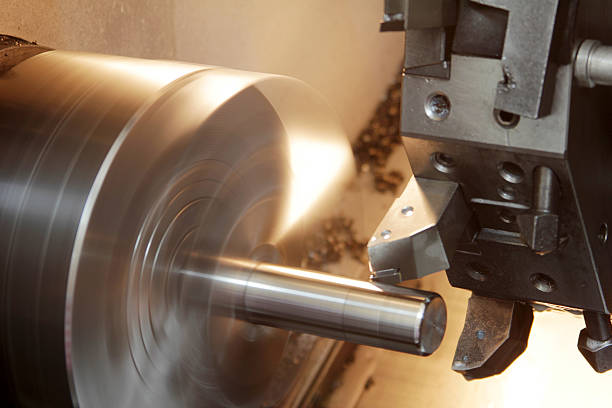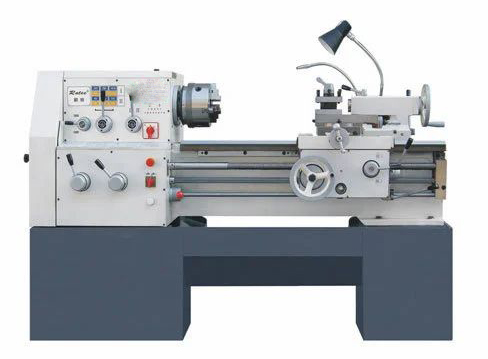Lathe is the best machining tool to shape raw materials like metals or wood into functional objects. It rotates the workpiece on its axis around a stationary cutting tool. This cutting tool works for precise cutting, drilling, and shaping. Thus, it removes unwanted parts and creates a shaped workpiece.
There are two main types of lathes: CNC and conventional lathes. Computer numerical control (CNC) lathes automate the process. Their programming system follows specific instructions to create highly precise materials. On the other hand, skilled operators manually handle conventional lathes, manipulating controls to get desired shapes.
In the 20th century, CNC lathes were discovered and evolved with the advancement in material science and digital control systems. Nowadays, lathes have been used to develop specialty items, including screws, candlesticks, instruments, bowls, and crankshafts. All types of lathes perform the same function of holding and rotating materials.
In this blog, you'll learn a comprehensive comparison between CNC lathes and conventional lathes, focusing on cost, accuracy, speed, precision, versatility, and applications. Get a clear understanding of both types of lathe machines.

CNC lathe automates and enhances the machine turning process with precision and efficiency. CNC lathes rely on computer programming to manage machining tasks, unlike conventional lathes.
Furthermore, the lathe has a workpiece at its core made of metal or plastic that connects to the rotating spindle. The CNC system interprets a pre-programmed set of instructions to control the movements of the cutting tool (present on the tool holder).
Cutting tool moves on multiple axes to shape materials and remove unwanted components. Computerized control systems allow machines to accurately cut, thread, and contour materials.
It's a manual lathe machine that shapes materials through rotational motion. Skilled operators control the process to achieve the desired product.
Workpiece fixes on the spindle rotating in a horizontal direction. Operators handle wheels and levers to move the cutting tool along the workpiece length and convert it into a perfect shape. However, the operator has to manage the speed, feed rate, and cutting depths to get accurate results.
When comparing the CNC and conventional lathes cost, you should consider initial and operating costs. Conventional lathe machines have lower initial costs than CNC lathes, while conventional lathes' operating costs are higher than CNC.
Since conventional lathe requires skilled laborers to operate the system, unlike lathe machines, CNC lathe doesn't need work staff and continuous monitoring.
However, due to their higher precision, you can manufacture greater parts through CNC machines with less material wastage. Thus, manufacturers will generate money and profits faster.
All the above factors reduce CNC machines operating costs as a good investment works in the long run.
Several key factors influence the capital cost of conventional or CNC lathes.
Conventional Lathe: Initial capital cost of lathe machines is lower because it requires investment only in basic tooling and machinery parts.
CNC Lathe: These lathes often come with higher capital costs due to the advanced technology. You must invest in the control system, programming software, tool holders, and components. Despite the higher costs, CNC lathes perform automation that saves costs and produces a higher volume of products.
Operating costs determine the overall efficiency of machining operations. It's crucial to understand these factors to optimize the manufacturing process.
Manufacturers hire skilled workers to control the machines. Thus it leads to higher labor costs. At the same time, CNC lathe operates on their programs, so it works with minimal human intervention reducing expenses.
CNC lathes consume less energy than other lathe machines. It's because CNC lathes of machinery parts have optimized their cutting edges.
Both types of lathes require routine maintenance. However, due to its electronic and mechanical components, the CNC lathe demands higher maintenance.
You've to change and adjust tools frequently in conventional lathes, thus increasing tool expenses. CNC lathes have optimized tool usage systems, so it reduces replacement costs.
CNC lathes have been programmed for easy setup and changeover; it minimizes downtime and maximizes production efficiency.
Conventional ROI calculation includes labor costs, setup time, and potential equipment for better precision and production. CNC lathes ROI offer reduced labor, faster production, higher precision, and versatile task handling.
According to industry data, CNC lathes reduce labor costs by 50%, with a 25-40% increase in overall production. Also, a study by a manufacturing association indicates that using CNC technology has led to 20-50% productivity over five years.
Accuracy refers to 'how closely the actual dimensions and features of the workpiece align in the machine.' You've to produce components that fit together and function properly. The machine's accuracy is observed in Microns - µ (1 millimeter = 1000 microns).

Accuracy is a must to obtain a product that matches the required design. Let's compare the accuracy between conventional and CNC lathes.
Conventional Lathe: A skilled and experienced machine handler can help you provide high accuracy of conventional lathe. Manual controlling may involve human errors, while advanced skilled machines produce precise outcomes.
CNC Lathe: CNC lathes are more featured and skilled computerized automated machines. The programming tools and actions construct accurate, reliable, and repeatable results comparable to conventional lathes.
When deciding between the two types of lathe machines, businesses must assess their specific needs, production volumes, operational goals, and sources of errors.
Human errors are common in conventional lathes due to faults in operators' methods or fatigue. CNC lathes don't require operators since the machines have been programmed.
Temperature fluctuations, humidity, and vibrations in the working environment cause errors in the conventional lathe. CNC lathes equipped with sensors eliminate the environmental impact.
Both types of lathes might get through wear and tear over time, resulting in errors in accuracy. Regular maintenance keeps the machines away from such conditions.
Conventional lathes require adjustments, while CNC lathes are calibrated to improve the lathe machines' accuracy.
CNC lathe has an accuracy level of 0.001mm, helping to achieve consistent quality in large productions. On the other hand, a conventional lathe shows deviations of 0.01mm depending on the operator's skill and other factors.
Looking into the aerospace manufacturing process, it has an accuracy of 0.002mm, thus meeting the industry requirements. Meanwhile, conventional machines produce with an accuracy of 0.01mm.
Speed and precision are two pillars of machining, shaping quality and efficiency. Precision is found at tight tolerances, such as aerospace and medical equipment manufacturing.
Speed is the rate of cutting tools and workpiece movement. It's the time required to complete a machine process.
Precision is the degree of accuracy in executing operations. It plays a role in maintaining the quality and functionality of the product.
The conventional lathe has a moderate speed for product manufacturing. This manual operation includes variations and operators' skill sets, affecting precision and speed. CNC lathes excel in both factors.
Here are factors you need to know before choosing any one lathe:
Higher speeds remove unwanted materials faster, but the vibration reduces precision.
If the feed rates faster, it produces products at a good speed. But feed rate exceeding the limit damages tools.
Deeper cuts in the materials improve speed, but it might affect the precision if it's not controlled.
Having complete and proper tools cuts materials efficiently and gives precise shapes of products.
Harder materials slow production speed but create precise shapes due to less wear and tear.
The CNC programming system optimizes tools and their movements on materials to enhance speed and precision.
CNC lathe takes 30% less production time than conventional machines. They have a precision of 0.002mm, and conventional lathes maintain a precision of 0.01mm.
Machines' versatility is their ability to adapt and transform to create diverse products and components. Let's discuss the versatility of conventional and CNC lathes and their advantages and limitations.
Versatility is the machine's capacity to make components and products of different designs, sizes, shapes, and materials. It allows manufacturers to transition between various tasks.
Conventional lathes produce simple components, such as shafts and cylinders. Thus, they offer versatility. CNC lathes manufacture complex parts demanding higher precision. Products range from medical instruments to airplane machinery parts.
Here are some advantages and limitations of conventional lathes:
● Ideal for simple designs
● Focuses on customization
● Offers cost-effective solutions
● Can't produces products with intricate geometry
● Difficult to craft exotic materials
● It can't handle large components.

Check out the advantage and limitations of CNC lathe to understand what's better:
● Produces complex designs with precision
● Handles a variety of materials, including metals and plastic
● Manages both small and large components
● Focuses on creating precise materials
● Higher setup and maintenance cost
● Require skilled programmers and software experts
CNC lathe produces complex aerospace components at a tolerance of 0.001mm. Also, these lathes craft surgical instruments with higher precision. In contrast, conventional lathes produce custom-designed furniture pieces.
Conventional and CNC lathes are found in different industrial sectors according to their requirements. Depending on quality, accuracy, and innovation, the domains of these lathes are divided into various applications.
Conventional machines are required for repairing and building custom parts. In contrast, the demand for perfection and speed are quite challenging for conventional lathes.
However, CNC lathe excels in automotive manufacturing due to their high accuracy and precision. They construct high-standard and quality products. For instance, advanced engine components, transmission parts, and other mechanical tools.
Conventional lathe machines are used for specific tools and equipment in aerospace. However, the limitations and restrictions can be a barrier to it.
CNC machines are highly demanded for quantity and quality production. These lathes are used to manufacture blades, gear components, and structural modules.
Small medical devices can easily be built and repaired using conventional lathes, but precision might be a great task.
The fragile and delicate surgical tools, implants, and other treating equipment are handed over to CNC lathes for quality and high-precision results. With the help of such advanced-level machines, medical needs are widely supported.
Conventional lathes might meet your expectations to manufacture good quality, uniquely designed furniture.
CNC lathes produce intricate and professional designs with durable quality. They balance efficiency and allow the mass production of customized orders.
These industries use conventional lathes for simple components, but the demand for durable and unique products has been challenging. When this industry requires precise and reliable machinery parts, they use a CNC lathe. These lathes create valve bodies, connectors, and drilling parts, meeting companies' quality standards.
The aerospace industry reports using CNC lathes have increased by 30% of product efficiency. It increases by 20% accuracy in surgical instruments, reducing error risks. Also, the furniture industry experiences a 25% rise in output with CNC lathes.
You've now learned the difference between conventional and CNC lathes depending on the cost, accuracy, speed, precision, and versatility. It will help you decide which lathe suits your needs.
CNC lathes are precise and efficient automation tools that handle large-scale production and make complex designs. While conventional lathes require a direct process to create custom work.
If you need a precise, consistent, and efficient product, prefer CNC lathes. Companies demanding personal and artistic touch can go for conventional lathes.
Choosing between these lathes isn't about machines but creating a perfect design. So, whether you prefer conventional or CNC lathes, your choice affects the quality of the products and your brand's reputation.